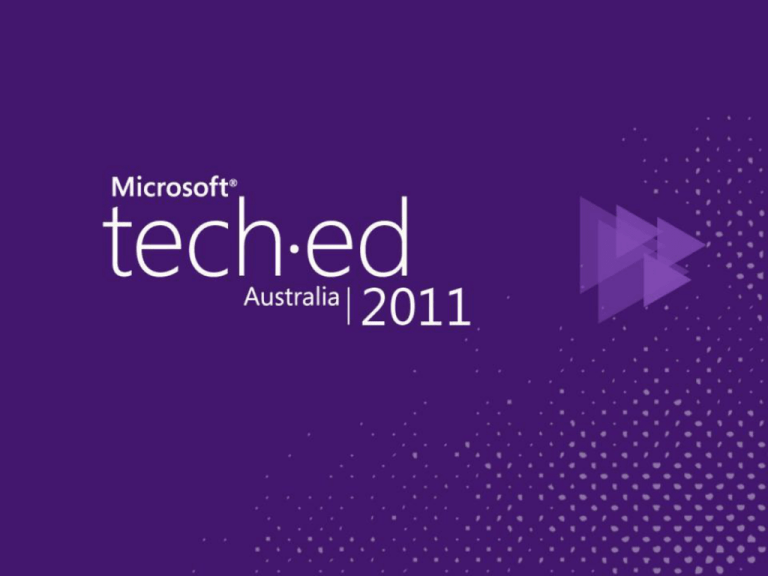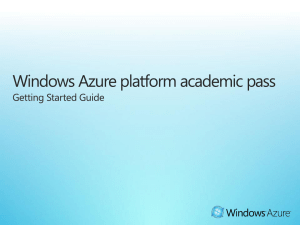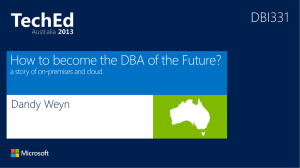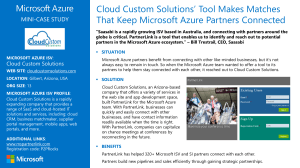
SESSION CODE: COS201
Tom Hollander
Architect
Microsoft Australia
APPLICATION LIFECYCLE
MANAGEMENT FOR WINDOWS
AZURE PROJECTS
(c) 2011 Microsoft. All rights reserved.
Agenda
► Introduction
► Build
► Deployment
► Testing
► Operations
(c) 2011 Microsoft. All rights reserved.
INTRODUCTION
Application Lifecycle Management
► Application
Lifecycle
Management
(ALM) is a
continuous
process of
managing the life
of an application
through
governance,
development and
maintenance.
Governance
Operations
Requirements
Deployment
Specification
Testing
Architecture
Build
Design
Development
Typical Activities
Build
Deployment
Testing
Operations
Compile
Upload
Functional Test
Monitor
Configure
Install
Acceptance Test
Manage
Package
Verify
Load Test
Support
Windows Azure Environment Concepts
Billing
Unit of Payment
Subscription
Unit of Management
Service
Represents a single application
Deployment
Two slots: Production & Staging
Role
Unit of Scaling
Instance
Running VM
Typical Environments
Development Billing Account
Operations Billing Account
BUILD
Build and Deployment Overview
Developer
Workstation
Build
Code
Compute
Emulator
Code
TFS
Build Server
Deployment
Test
Environment
Production
Environment
Build: Continuous Integration
► Compile
► Verify – Run Unit Tests
► Ideally, this is not different than traditional CI,
since Unit Tests should be testing classes, not
integration.
Build: Daily Build
► Compile
► Verify – Run Unit Tests
► Update Configuration
► Package
► … continue with Deploy
Build Approaches
► MSBuild targets
– Azure SDK includes targets for packaging
– Customize .ccproj files or write your own msbuild
scripts
– Can be integrated with TFS Build or 3rd party ALM
tools
► TFS-specific
– Custom XAML build process
– Custom activities
► Scripts
– PowerShell
Build: Update Configuration
► Most applications require different configuration
for each environment
– Connection Strings, VM sizes and instances,
Dependent system URIs, etc.
► Changes to configuration should be controlled
– Per-environment settings checked in to source control
– Automatically applied for target environment as part
of build server
Build: Update Configuration
► Understand where your configuration
lives
– ServiceConfiguration.cscfg is outside of the
deployed package – can be applied after
packaging
– Web.config and ServiceDefinition.csdef are
inside the package – must my applied before
packaging
► Transformation approaches
– Web.config transforms, TransformXml target
to apply to custom files
– XSLT
– Custom approaches
Package
assemblies
web.config
ServiceDefinition
.csdef
ServiceConfiguration
.cscfg
Build: Create the deployment package
► Windows Azure applications are deployed as an
encrypted package (*.cspkg)
► Automatically created by Visual Studio when you
publish
► CSPACK command line tool
► Easiest approach for automated builds:
CorePublish target
► Watch out for application dependencies
– GAC’d Assemblies
– Secondary web sites
DEPLOYMENT
.cspkg
.cscfg
Deploy: To the Cloud
MSBuild
► To one or more target
environments (Test, Production)
► Ideally executed as a part of daily
build
► Normally implemented via
PowerShell scripts using Azure
cmdlets, triggered from MSBuild
► Requires Azure Management
Certificate deployed to build server
PowerShell
Deploy Script
Azure cmdlets
Azure Management
API
Windows Azure
Deployments
Deploy: To the Cloud
► Typical steps
– Deploy service certificates
– Upload package to Blob Storage
– Deploy package + ServiceConfiguration to Staging
slot
– Run automatic verification tests
– Flip Staging to Production
– Stop and delete Staging deployment
► To save money, delete unused deployments
when no longer needed (Staging and
Production)
Deploy: WebDeploy?
► Allows code to be uploaded to the cloud without
going through a full deployment process
– New code is there in seconds, not 10-30 minutes
► OK for developers to test/troubleshoot in the
cloud
► Not recommended for test or production
environments
– Only supported for web roles, not worker roles
– Only supports 1 instance per role
– Changes are not durable
Example: Targets in .ccproj project file
<PropertyGroup>
<PackageName>$(AssemblyName).cspkg</PackageName>
<ServiceConfigName>ServiceConfiguration.cscfg</ServiceConfigName>
<PackageLocation>$(OutDir)Publish</PackageLocation>
</PropertyGroup>
<Target Name="AzureDeploy" AfterTargets="Build"
DependsOnTargets="CorePublish"
Condition="$(AzureDeployEnvironment)!=''">
<Exec WorkingDirectory="$(MSBuildProjectDirectory)" Command="
$(windir)\system32\WindowsPowerShell\v1.0\powershell.exe -f
\build\AzureDeploy.ps1 $(AzureSubscriptionID)
$(AzureCertificateThumbprint) $(PackageLocation)
$(PackageName) $(ServiceConfigName)
$(AzureHostedServiceName) $(AzureStorageAccountName)" />
</Target>
Example: Deployment Script
$hostedService = Get-HostedService $servicename -Certificate $cert
-SubscriptionId $sub | Get-Deployment -Slot Staging
if ($hostedService.Status -ne $null) {
$hostedService | Set-DeploymentStatus 'Suspended' |
Get-OperationStatus -WaitToComplete
$hostedService | Remove-Deployment | Get-OperationStatus
-WaitToComplete
}
Get-HostedService $servicename -Certificate $cert -SubscriptionId $sub
| New-Deployment Staging -package $package -configuration $config
-label $buildLabel -serviceName $servicename
-StorageServiceName $storageAccount
| Get-OperationStatus -WaitToComplete
Get-HostedService $servicename -Certificate $cert -SubscriptionId $sub |
Get-Deployment -Slot Staging |
Set-DeploymentStatus 'Running' |
Get-OperationStatus -WaitToComplete
/p:AzureDeployEnvironment="Test" /p:AzureSubscriptionID="847d5f81-1111-22229984-af8c008ba1b7"
/p:AzureCertificateThumbprint="A38242009E0A1A4DDC0000111122220D943C98E8"
/p:AzureHostedServiceName="myservice" /p:AzureStorageAccountName="mystorage"
Deploy: To the Compute Emulator
► Why?
– Can be used for Unit Tests testing more than just
classes (integration tests)
– Can be used for Functional Testing on internal servers
(but cloud normally makes more sense)
► How?
– Package to .csx folder using CSPACK /copyOnly or
CorePackageComputeService MSBuild target
– Stop and start the Compute Emulator using CSRUN
– Redirect network ports to allow external access
Deploy: To SQL Azure
► Developers should have their own SQL Server
sandbox.
► Use VSDB (“Data Dude”) to manage scripts for the
SQL Server database.
► Challenge: VSDB doesn’t support SQL Azure syntax
differences / limitations. Solutions:
– Use the new Data Tier Application (DAC) project type
– Generate scripts using SQL Management Studio
– Migrate scripts / data using SQL Azure Migration Wizard
from CodePlex
– Tweak SQL Server scripts by hand
► Scripts can be executed as a part of deployment
– Use CREATE DATABASE AS COPY for backup
TESTING
Functional Test: In the Cloud
► Whereas functional testing can be performed on
the Compute Emulator, it will also have to be run
later in the cloud.
► Normally executed as automated User Interface
tests, run on local servers accessing the cloud.
► A subset of functional tests (“Build Verification
Tests”) can be run after deployment to the
staging slot before flipping into production.
Load Test: Key Decisions
► Where to generate
the load?
– In the cloud
• No latency
• Provision and scale ondemand
• Low bandwidth costs
– Outside the cloud
• Realistic latency
• Full control
• Higher Bandwidth costs
► What tools to use?
– Custom developed
tools
– Traditional load testing
products
• e.g. Visual Studio 2010
– SaaS offerings
• e.g. SOASTA
Visual Studio Load Testing from the Cloud
► Decisions
– Where to run Visual Studio, Controller, Agents, Database
– VM Role versus Worker Role
► Communication between cloud and on-premises
environment
–
–
–
–
Windows Azure Connect configuration
Provisioning sequence
Firewalls
Latency
► Local user accounts and password synchronisation
Visual Studio Load Testing from the Cloud
Internal Systems
Windows Azure
Test Data
Report Data
Test
Test
Visual Studio
Test Controller
Application
Test
Test Agent
Performance Data
Load Test: From the Outside
► Tests the true scenario.
► Best for performance testing, where true
response times during load is measured.
► Can be tested as any internal server using Visual
Studio or similar.
– Can use Azure Connect to access performance
counters directly, or Azure Diagnostics to access
indirectly.
► 3rd party test specialist SOASTA a scalable SaaS
solution for load testing
OPERATIONS
Operations for Cloud Applications
Infrastructure
Platform
Software
Applications
Applications
Data
Data
Runtime
Runtime
Runtime
Middleware
Middleware
Middleware
Middleware
O/S
O/S
O/S
Virtualization
Virtualization
Servers
Servers
Storage
Storage
Networking
Networking
(On-Premises)
Data
Virtualization
Servers
Managed by vendor
Managed by vendor
You manage
Data
(as a Service)
O/S
Virtualization
Servers
Storage
Storage
Networking
Networking
Managed by vendor
Runtime
Applications
You manage
Applications
(as a Service)
You manage
(as a Service)
Monitor
► Monitor the Azure Service Dashboard for general
availability.
► Use System Center Operations Manager
Windows Azure Management Pack to monitor
instance and app health
– Cerebrata Diagnostics Manager is an alternative.
► Develop synthetic transactions to monitor that
the whole application is up end-to-end.
► Use Dynamic Management Views to monitor
SQL Azure.
Monitor: Diagnostics
Visual Studio
Remote Desktop
Scheduled
Transfers
Role Instance
Trace Listeners,
Instrumentation
DiagnosticMonitor
TraceListener
System Center
Operations Manager
Blob
Azure Storage
3rd Party Tools
System Center Operations Manager
Cerebrata Azure Diagnostics Manager
Manage: Authentication
► Implement policies and routines for handling:
– Windows Live ID credentials for Azure management
portal
– Management Certificates
► Minimise access to Azure management portal
– Use tools based on Management API
– Certificates secured using corporate user accounts
► Use different subscriptions for dev/test and
production
Windows Azure Platform Management Tool
Manage: Scaling
► Windows Azure’s “elasticity” allows applications
to be scaled up and down based on demand
► Platform directly supports manual scaling from
portal or APIs
► Automated scaling can be built easily on top of
APIs
– Time-Based: E.g. console application triggered from
Windows Scheduler
– Resource-Based: Worker role that monitors KPIs such
as performance counters and adds/removes instances
when needed.
Scale up/down
Analyze
+1
-1
Azure Management API
Resource-based Autoscaling
Performance Counters
Sample Period
Read
Summary
Build
Deployment
Testing
Operations
Compile
Upload
Functional Test
Monitor
Configure
Install
Acceptance Test
Manage
Package
Verify
Load Test
Support
tom.hollander@microsoft.com
http://blogs.msdn.com/tomholl
QUESTION & ANSWER
SESSION
(c) 2011 Microsoft. All rights reserved.
<Prizes & Process TBC>
COMPLETE AN EVALUATION
ONLINE AND ENTER TO WIN
THESE PRIZES!
(c) 2011 Microsoft. All rights reserved.
© 2010 Microsoft Corporation. All rights reserved. Microsoft, Windows, Windows Vista and other product names are or may be registered trademarks and/or trademarks in the U.S. and/or other
countries.
The information herein is for informational purposes only and represents the current view of Microsoft Corporation as of the date of this presentation. Because Microsoft must respond to changing
market conditions, it should not be interpreted to be a commitment on the part of Microsoft, and Microsoft cannot guarantee the accuracy of any information provided after the date of this
presentation. MICROSOFT MAKES NO WARRANTIES, EXPRESS, IMPLIED OR STATUTORY, AS TO THE INFORMATION IN THIS PRESENTATION.
(c) 2011 Microsoft. All rights reserved.
PowerPoint Template
Subtitle color
► Example of a slide with a subhead
– Set the slide header to “Title Case”
– Set subheads in “sentence case”
– Generally set subhead to 36pt or smaller so it will fit
on a single line
– The subhead color is defined for this template but
must be selected; In PowerPoint 2010, it is the fifth
font color from the left
(c) 2011 Microsoft. All rights reserved.
PowerPoint Guidelines
► Font, size, and color for text have been
formatted for you in the Slide Master
► Use the color palette shown below
► Hyperlink color: www.microsoft.com
Sample
Fill
Sample
Fill
Sample
Fill
Sample
Fill
(c) 2011 Microsoft. All rights reserved.
Sample
Fill
Sample
Fill
Slide for Showing Software Code
► Use this layout to show software code
– The font is Consolas, a monospace font
– The slide doesn’t use bullets but levels can be
indented using the “Increase List Level” icon on the
Home menu
– To use straight quotes " instead of
smart quotes ”, do this:
1.Click on the Office Button in the upper left corner
2.At the bottom of the menu, choose PowerPoint Options
3.From the left pane, select Proofing
4.Click on the AutoCorrect Options button
5.Select the AutoFormat As You Type tab,
and deselect “Straight quotes” with “smart
quotes”. Then Click OK.
(c) 2011 Microsoft. All rights reserved.
Table Format
Table Title
Column 1
Column 2
Column 3
Column 4
(c) 2011 Microsoft. All rights reserved.
Column 5
Bar Chart Example
Chart Title
5
4.5
4.4
4.3
3.5
3
2.4
2.5
2
2
Category 1
Category 2
Series 1
2.8
1.8
Category 3
Series 2
Series 3
(c) 2011 Microsoft. All rights reserved.
Category 4
Pie Chart Example
Chart Title
10%
9%
1st Qtr
23%
58%
2nd Qtr
3rd Qtr
4th Qtr
(c) 2011 Microsoft. All rights reserved.
QUESTION & ANSWER
SESSION
(c) 2011 Microsoft. All rights reserved.
Enrol in Microsoft Virtual Academy Today
Why Enroll, other than it being free?
The MVA helps improve your IT skill set and advance your career with a free, easy to access
training portal that allows you to learn at your own pace, focusing on Microsoft
technologies.
What Do I get for enrolment?
► Free training to make you become the Cloud-Hero in my Organization
► Help mastering your Training Path and get the recognition
► Connect with other IT Pros and discuss The Cloud
Where do I Enrol?
www.microsoftvirtualacademy.com
Then tell us what you think. TellTheDean@microsoft.com
Resources
www.msteched.com/Australia
www.microsoft.com/australia/learning
Sessions On-Demand & Community
Microsoft Certification & Training Resources
http:// technet.microsoft.com/en-au
http://msdn.microsoft.com/en-au
Resources for IT Professionals
Resources for Developers
(c) 2011 Microsoft. All rights reserved.
© 2010 Microsoft Corporation. All rights reserved. Microsoft, Windows, Windows Vista and other product names are or may be registered trademarks and/or trademarks in the U.S. and/or other
countries.
The information herein is for informational purposes only and represents the current view of Microsoft Corporation as of the date of this presentation. Because Microsoft must respond to changing
market conditions, it should not be interpreted to be a commitment on the part of Microsoft, and Microsoft cannot guarantee the accuracy of any information provided after the date of this
presentation. MICROSOFT MAKES NO WARRANTIES, EXPRESS, IMPLIED OR STATUTORY, AS TO THE INFORMATION IN THIS PRESENTATION.
(c) 2011 Microsoft. All rights reserved.






